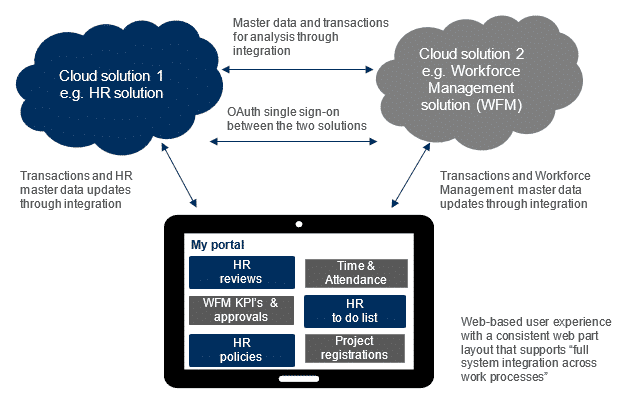Technical debt can have considerable consequences for the company’s efficiency and ability to retain and attract employees – and, in turn, its competitiveness. Learn more about what you can do to reduce it.
Being in debt is not a nice feeling. And, the greater the debt, the worse the feeling. Not only does it kill new thoughts and ideas, it also means that your room for manoeuvre becomes more and more limited over time.
On the other hand, you gain a certain freedom when you are not (heavily) in debt, and you are free to choose what to respond to, what to invest in and which projects and experiences you would like to realise.
Debt – the company’s worst enemy
The same debt principle applies when it comes to IT systems – and consequently, also to the work processes you offer your employees. Moreover, it can have considerable consequences for the company’s efficiency and ability to retain and attract employees – and, in turn, its competitiveness.
Increasingly, employees expect modern, recognisable and optimised user interfaces, full system integration across their work processes, operational reliability, and that data security is in place. These conditions are particularly important to the sizeable generation from the mid-90s, known as Generation Z, who are making their way in to the labour market:
Age-wise, they are between 14 and 24 years old, and the oldest among them are on their way into the labour market. We can expect to come across some super-competent ‘digital natives’ who have a great understanding of networks and business in the multi-global world with “the northern province” as the starting point (source: Dansk HR, Jan 2015).
These are the employees that must be attracted and retained to assure the future of the company. And that requires that you are not weighed down by debt!
What is technical debt?
The term ‘technical debt’ covers an IT system landscape that has not kept abreast of the times. Technologies and solutions which, for a variety of reasons, have either not been upgraded and updated, have been degraded with hot fixes and stop-gap solutions or where new systems have emerged on an ongoing basis like buds in the garden without any kind of long-term perspective. The result is often that the company builds up manual processes that are not only time-consuming but also increase the risk of errors.
Moreover, the operation and development of the systems will be more or less people-dependent, which renders the company even more vulnerable.
Among critical business systems, such as Workforce Management solutions, there are some classic challenges which create technical debt. Thus, these challenges will rapidly become a burning platform for the company:
- End-of-life of the product, end of support from the supplier or the supplier not being able to deliver in accordance with the company’s future strategy
- The system has difficulties in supporting the vision of “full system integration across work processes” and in continually offering employees the expected modern user experiences
- Self-developed systems that have become too complex and expensive to maintain, do not have the necessary documentation and/or are too people-dependent
- Business rules and logic that have been specifically coded in the solution which make upgrades complex and cost-intensive
- It is too cost-intensive or not possible to keep up with the security and operational requirements imposed on modern business systems
How to reduce technical debt
There are several areas companies can work on in order to reduce their technical debt:
- Establish a web-based solution which minimises the costs of roll-out and operation of the solution
- Use intuitive, role-based user interfaces that give the users the best possible experience
- Implement an open business system that can be integrated, not just in terms of data, but also in terms of business logic. This makes it possible to execute on “full system integration across work processes”
- Use a system architecture that can be scaled in relation to current and future business needs
- Increase the requirements for the system and the supplier of the system in areas such as data security, operational reliability and compliance (for example, compliance with GDPR, the EU’s general data protection regulation)
- Ensure continual system upgrades in order to eliminate technical debt overall
- Implement Software as a Service* (SaaS) via a stable supplier who is able to deliver in accordance with the company’s strategy, with a service level that can be adjusted to keep pace with requirements over time *(cloud-based application, billed according to use)
The generally specialised solution
Many companies struggle to address technical debt in the entire system landscape across a large number of business applications. Here, two approaches have traditionally been adopted:
| Best-of-Suite | Best-of-Breed |
|---|---|
| The strategy is that a single large business system can provide “full system integration across work processes”. However, many companies experience that this approach is cost-intensive because: • It often results in customer-specific coding of solutions in the business system, which in turn creates costly debt in relation to upgrades (all-or-nothing upgrades). Moreover, the centralised architecture creates dependencies which can be limiting in relation to agile business needs • It cannot be expected that suppliers of Best-of-Suite software can address the latest knowledge, trends and technologies across their entire business suite in a world that is constantly changing • Most companies with a Best-of-Suite strategy still end up using complementary add-on solutions in order to fully support their business processes. In certain cases, manual work processes are nevertheless retained, due to a lack of flexibility in the business suite solution | Conversely, the Best-of-Breed strategy is based on integrating more or less specialised solutions in order to achieve “full system integration across work processes”. Companies following this strategy also struggle with costs because: • Historically, specialised systems have had limited and non-standardised integration options and integration projects have been very cost-intensive • Integrations have primarily involved data rather than an overall intuitive user experience • Best of Breed suppliers do not necessarily have the strength and scale to be a future-proof option for the company |
The best of both worlds!
Both approaches each have their own advantages and challenges. And this can make the task of choosing one approach over the other difficult.
Fortunately, new technologies are opening up the possibility of using the best of both approaches. The modern solutions focus on:
- Standardised integration of data (via relevant standard integration protocols)
- Standardised integration of business logic (same as above)
- Standardised integration of security (for example, single sign-on via OAuth2 (access to all systems with a single log-in)
- Uniform user experience across the underlying business systems (for example, web portals with web parts for underlying business systems)
- Scalable, secure operation (for example, via a cloud set-up)
- The right supplier support for handling operation, security and integrated solutions
An architecture that build on these principles could look like this:

The user experience can be delivered via, for example, an intranet portal framework or via one of the cloud solutions’ platforms that integrates the other cloud solution’s web parts.
ProMark – a future-proof solution
ProMark is a standard Best-of-Breed software solution, developed with the market’s latest technologies from innovative partners. Through integration with ERP, HR and payroll systems – and, consequently, the exchange of data – the company obtains flexible and effective support of their business processes.
Our philosophy is that ProMark should be where the user is and facilitate easy, effortless registration of data. Hence, we focus intensely on interoperability and ensure that our solution is accessible via a large number of registration devices, including terminals, portals and mobile devices – without compromising on security. Other focus areas in our development work are simple deployment, optimal performance and scalability – and that everything is documented.
Thus, ProMark is a future-proof solution that is continually being developed in order to support the business processes of large companies optimally. This provides an opportunity to reap efficiency gains, achieve savings and remain an attractive company.
Are the IT systems in your company ready to meet future requirements? Or are you struggling with technical debt too?


